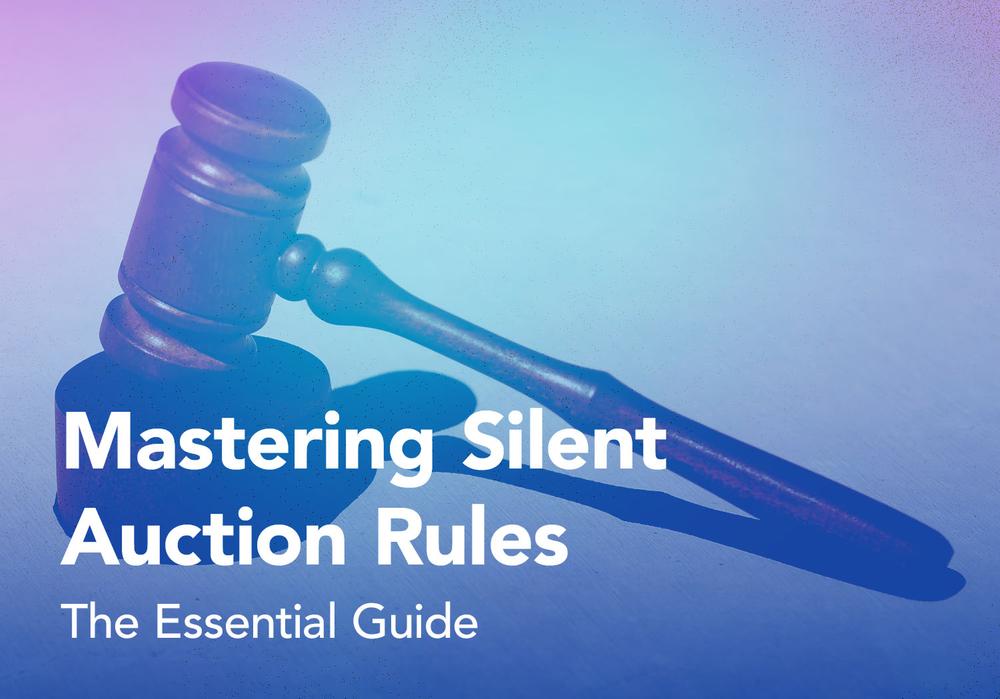Silent auctions are effective fundraising sources and lots of fun for attendees. When run successfully, either online or in-person, they can create memorable experiences and bring in impressive revenue.
To prepare for a profitable event night, it’s important to create clear rules for your auction attendees. These auction guidelines set expectations and determine etiquette for your event.
Plus, when bidders know the ins and outs of your auction, they’ll be much more likely to enthusiastically participate. To elevate your auction, we’ll cover:
- Bidder Registration Expectations
- Auction Item Guidelines
- Bidding Process Procedures
- Legal Restriction Considerations
- Closing Bid Rules
- Checkout Procedures
Review these rules one by one, or jump to a section for clarification on one particular guideline.
After gathering insight for each auction rule, check out our downloadable silent auction rule examples.
Let’s get started!
Bidder Registration Expectations
For the best auction experience, outline bidder registration rules for auction guests to read and agree to before event night. You can do this by using silent auction software to pre-register your guests and prompt them to accept your regulations online in order to purchase their tickets.
Other bidder registration best practices include:
- Preparing a written copy of the rules in your auction program to reference for in-person silent auctions
- Instructing volunteers to efficiently answer registration-related questions
- Designating a software lead to provide support and oversight before and during the silent auction. Their job is to oversee all data entry points, troubleshoot check-in and check-out, and manage incoming registration.

Auction Item Guidelines
Provide auction item guidelines to give attendees context and keep your event running smoothly. Here are some common examples of item guidelines:
- All sales are final. Communicate that item exchanges are not permitted and all items are sold “as is.”
- Minimum bids will be 30-50% of an item’s FMV (Fair Market Value). Explain how starting bids are calculated to give attendees additional context.
- Limits may apply. Communicate to bidders that blackout dates, restaurant certificates, airfare, and hotel stays are all subject to changes in availability.
- Items are sold as-is. Reiterate that It is the bidder’s responsibility to inspect all auction items and items cannot be returned.

Bidding Process Procedures
To monitor your event’s bidding flow, it’s important to spell out bidding process procedures and expectations. These guidelines typically include:
- Bidding start and end times. We suggest grouping items into several different “closings.” You can also enable automatic bid extensions to provide longer bid times for items that are still receiving final bids.
- Minimum requirements. Let your guests know that an item cannot be bid on below the stated minimum bid.
- Minimum bid increments. Ensure attendees are aware that bids below the minimum bid amount will not be accepted. If you use silent auction software, this feature is built into the bidding process.
- Explain whether bids can be altered or withdrawn. Make bidders aware of the consequence each bid carries. If attendees know bids cannot be altered, they’re likely to adjust their bidding strategy.

Our Software Elevates Your Silent Auction
Legal Restriction Considerations
Update your silent auction rules to include the necessary legal restrictions:
- Age restrictions. Let attendees know that certain items such as wine baskets may not be purchased by underage bidders. Mention that a valid ID must be shown upon purchase of age-restricted items.
- Bidder assumes all risk. You don’t want to be held liable If a bidder purchases dance lessons and twists their ankle while learning to salsa. Make sure to include a clause specifying that bidders assume all risks associated with the prize they’ve won.
- Items may change or be withdrawn without notice. To cover your organization’s bases, mention that items may change as needed.
- Sales tax considerations. Mention that any purchases above the fair market value of items may be tax deductible. Recommend that bidders consult with a tax advisor for specifics.

Closing Bid Rules
Finish up your silent auction with a clear set of closing bid rules:
- The highest qualifying bid or the bidder who chose the “Buy-it-Now” option wins each item
- Bidders agree to pay in full at the end of the auction
- No additional bids may be placed once an item has been closed

Checkout Procedures
Make matching auction winners with their items simple. To set your silent auction up for checkout success, implement these procedures:
- Winners are required to show confirmation of their payment to pick up their items
- Unclaimed items will become the property of the school or organization
- Winners must claim all items by the end of the night

Silent Auction Rules Example Template
Now that you know the details of your auction rules, it’s time to draft your own list!
Download this free template or use it as a starting point to outline your silent auction guidelines:
[Organization Name]
Auction Rules
- To participate in the bidding, each attendee must agree to the rules and regulations presented before the event. By completing your registration for the event, you are agreeing to these regulations.
- The organization reserves the right to withdraw or add auction items, without notice, to or from the organization.
- A valid bid must adhere to the minimum bid guidelines and increment guidelines.
- Sections will close following a 5-minute warning and a 1-minute warning
- The silent auction will close at XX:XX p.m. Once the auction closes, additional bids will not be accepted or valid.
- The highest qualifying bid within the bid guidelines at the close of the auction will be declared the winning bid.
- Winning bidders will be notified via their smartphones once an auction item has been declared "closed". The bidder will then be instructed on how to pick up their auction item.
- A credit card must be placed on file prior to the auction. Payments for items purchased must be paid in full on the night of the auction.
- Winners must pick up their auction items at the checkout area.
- Unclaimed items will become the property of the organization, regardless of if a bidder has paid for an item.
- All sales are final. Exchanges and refunds are not permitted. No item may be redeemed for cash. An item's safety and security are the winning bidder's responsibility once claimed.
- The organization is not responsible for items left after the event. No refunds will be given for items that are left behind.
- Each person assumes all related risks and hazards of auction items obtained at the event. Each bidder agrees to hold [your organization's name] harmless from any liability arising indirectly from the organization, their appointed officials, members, employees, event organizers, sponsors, and volunteers.
- Some items are subject to limitations/restrictions listed in the catalog and/or on the gift certificates. Hotel, theater, airfare, and restaurant items may be subject to "blackout" dates.
- It is the responsibility of the buyer to make arrangements with the donor as indicated for auction services that must be performed or ordered.
- Auction item value listed is based on FMV (Fair Market Value). Unless noted otherwise, items have not been appraised. If the organization is registered as a school district program or 501c(3) nonprofit, any bid over the value of an item is tax deductible. Buyers should consult with a tax advisor to determine the amount of deduction.
Conclusion and Additional Resources
Now you’re a pro on silent rules and best practices! Keep your auction momentum going with these resources to raise more for your mission:
- 37 Must-Have School Auction Ideas to Help You Raise More. Check out our ultimate list of 37 school auction ideas for your next school fundraiser.
- Silent Auction Software Platforms to Reach Your Fundraising Goals. Level up your silent auction with fast and reliable software platforms.
- 5 Ways to Simplify Your Elementary School Fundraiser. Learn how to use digital tools to reach your school fundraising goals.




